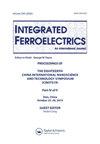(Bi 0.5 (Na 0.80 K 0.20) 0.5) 1- x (Ba 0.7 Sr 0.3) x tio3无铅压电陶瓷的相变、物理和电学性能的相关性
IF 0.7
4区 工程技术
Q4 ENGINEERING, ELECTRICAL & ELECTRONIC
引用次数: 0
摘要
摘要采用常规一步混合氧化法制备了(Bi0.5(Na0.80K0.20)0.5)1-x(Ba0.7Sr0.3)xTiO3或(BiNK)1-x(BaS)xT (x = 0、0.01、0.02、0.03、0.04、0.05和0.06 mol分数)无铅压电陶瓷,在1125℃下烧结2 h,升温速率为5℃/min。所有样品的最佳相对密度为~ 97-98%。XRD结果表明,制备的样品中均未检测到杂质相。SEM图像显示,所有陶瓷都具有不规则形状的颗粒。BST的添加量对BNKT陶瓷的电学性能也有影响。(BiNK)0.98(BaS)0.02T样品具有良好的介电(εr = 1577, tanδ = 0.0855)和铁电性能(Pr = 11.38µC/cm2, Ec = 19.89 kV/cm),压电系数(d33 = 164 pC/N)最高。关键词:无铅压电陶瓷铋钠钛钾介电行为披露声明作者未报告潜在利益冲突。本研究项目由TSRI和泰国国家研究委员会(NRCT)支持:NRCT5-RSA63004-15。同时也得到了清迈大学理学院物理与材料科学系材料科学与技术卓越中心的部分支持。P. Wannasut和P. Jaita感谢清迈大学研究管理办公室的资助。Promsawat先生要感谢橡胶产品和创新发展研究中心(SCIRU63002)。本文章由计算机程序翻译,如有差异,请以英文原文为准。
Correlation between Phase Evolution, Physical and Electrical Properties of (Bi 0.5 (Na 0.80 K 0.20 ) 0.5 ) 1- x (Ba 0.7 Sr 0.3 ) x TiO 3 Lead-Free Piezoelectric Ceramics
AbstractThe (Bi0.5(Na0.80K0.20)0.5)1-x(Ba0.7Sr0.3)xTiO3 or (BiNK)1-x(BaS)xT (x = 0, 0.01, 0.02, 0.03, 0.04, 0.05 and 0.06 mol fraction) lead-free piezoelectric ceramics were firstly made by a conventional one step mixed-oxide method and sintered at 1125 °C for 2 h with a heating rate of 5 °C/min. All samples showed optimum relative densities of ∼97–98%. The XRD result indicated that no impurity phase was detected in all fabricated samples. SEM images indicated that all ceramics possessed irregular shaped grains. It was also found that BST added content had an effect on electrical properties of BNKT ceramics. The highest piezoelectric coefficient (d33 = 164 pC/N) with good dielectric (εr = 1577, tanδ = 0.0855) and ferroelectric properties (Pr = 11.38 µC/cm2, Ec = 19.89 kV/cm) were obtained for (BiNK)0.98(BaS)0.02T sample.Keywords: Lead free piezoelectric ceramicsbismuth sodium potassium titanatedielectric behavior Disclosure StatementNo potential conflict of interest was reported by the author(s).Additional informationFundingThis research project is supported by TSRI and National Research Council of Thailand (NRCT):NRCT5-RSA63004-15. Partial supports from the Center of Excellence in Materials Science and Technology, Department of Physics and Materials Science, Faculty of Science, Chiang Mai University are also acknowledged. P. Wannasut and P. Jaita would like to acknowledge funding from the Office of Research Administration, Chiang Mai University. M. Promsawat would like to thank Rubber Product and Innovation Development Research Unit (SCIRU63002).
求助全文
通过发布文献求助,成功后即可免费获取论文全文。
去求助
来源期刊

Integrated Ferroelectrics
工程技术-工程:电子与电气
CiteScore
1.40
自引率
0.00%
发文量
179
审稿时长
3 months
期刊介绍:
Integrated Ferroelectrics provides an international, interdisciplinary forum for electronic engineers and physicists as well as process and systems engineers, ceramicists, and chemists who are involved in research, design, development, manufacturing and utilization of integrated ferroelectric devices. Such devices unite ferroelectric films and semiconductor integrated circuit chips. The result is a new family of electronic devices, which combine the unique nonvolatile memory, pyroelectric, piezoelectric, photorefractive, radiation-hard, acoustic and/or dielectric properties of ferroelectric materials with the dynamic memory, logic and/or amplification properties and miniaturization and low-cost advantages of semiconductor i.c. technology.
 求助内容:
求助内容: 应助结果提醒方式:
应助结果提醒方式:


